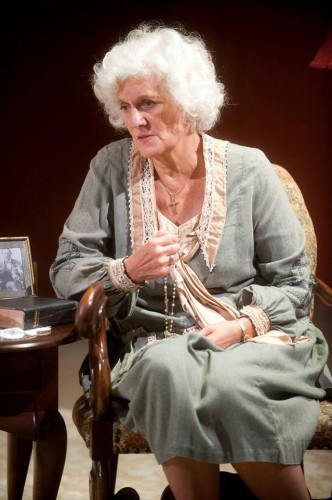Theater Feature: From Page to Stage — The Craft of Theatrical Adaptation, Part One
“A great novel makes for the best script an actor could imagine,” said actor Colin Firth recently, on accepting an award for his reading of Graham Greene’s The End of the Affair. Many theatergoers would agree.
Increasingly, stage adaptations of literary works (and popular films) are becoming de rigueur programming for mainstream theaters around the country. Where would the Broadway musical be without its dependence on blockbuster movies? The reasons for this dependence on comfy pedigrees are many, not all of them reassuring. Theater audiences are not comfortable taking chances on seeing new work, relying on the reassurance of familiar characters, proven material, classic authorial names, and pre-tested plots. Given the increasing enthusiasm for adaptations, what are the skills needed to create a successful transfer of literature to the stage? In the first of two reports, critic Helen Epstein interviews two playwrights who know what it takes to animate the literary on the footlights. — Bill Marx, Arts Fuse Editor
By Helen Epstein
This summer, I saw intriguing stage adaptations of short stories by Edith Wharton as well as theater versions of Balzac’s Cousin Bette and Charlotte Bronte’s Jane Eyre and became interested in the process. Daniel Elihu Kramer talked about his adaptation of Jane Eyre to The Arts Fuse here. As he suggests, theatrical adaptations typically shorten, simplify, summarize and interpret a work of literature. What’s in it for the adaptor? Is it easier to market an adaptation than original work? And how does the process work?
Catherine Taylor-Williams is the producer for the Wharton Salon at The Mount in Lenox, MA, and she commissions only adaptations. A “site-specific” theater, the Salon produces short plays adapted from Edith Wharton’s work and correspondence and that of her close friends such as Henry James. The plays are produced on the grounds of The Mount and most frequently engage members of Shakespeare & Company, who began the tradition of dramatizing her work after Tina Packer moved her new company into the then-decrepit country home in 1978. The challenges a succession of actors and playwrights have faced in adapting Wharton’s texts, include selecting which to adapt, how literal to be, for how many characters, in how many acts, and how to transform her descriptions, characterizations and observations into dialogue.
“Sometimes the stories are dialogue-heavy and lift easily from the page,” Taylor-Williams says. “Sometimes they don’t or there are gaps, and the playwright has to channel the author’s original intent and knit the pieces together. Sometimes original dialogue from a story doesn’t sound right on the stage and we need a more naturalistic rhythm or to remove words that sound too descriptive. We also on occasion insert interruptions, as in life. Sometimes we change the location of a scene, or cut a scene, or accelerate time so we have a piece that is tight enough for an audience to watch in an hour or two. Sometimes – Dennis Krausnick did this brilliantly in his adaptation of Wharton’s Summer – important descriptive passages are given to a chorus of townspeople, or a servant who can help us set up a scene.”
Taylor-Williams prefers not to discuss the economics of adaptations. “It’s more of an honorarium than a salary at this point,” she explains, “finances depend on if we get a grant. We currently do 10 performances and pay royalties to the Estate of Edith Wharton.” It’s clearly not for financial reasons that her stable of playwrights adapt Wharton’s work.
Elaine Smith calls herself “an accidental playwright” because she never intended to become one. She was an actor who, like so many other women in the theater, recognized the dearth of good roles for women “beyond the ingénue stage.” In 2003, she wrote Angels and Ministers of Grace Defend Us, an original play that will be produced by New Jersey Repertory next year.
Her adaptation of Edith Wharton’s story The Looking Glass is her first foray into the field. It began when long-time Shakespeare & Company actor and massage therapist Diane Prusha introduced Smith to the Wharton Salon and suggested she write a one-woman show.
“I read the story, liked it, and had an immediate sense of how it could be adapted,” recalls Smith, “but I had to make sure I understood the requirements of the producer. We discussed desired running time and cast size. I reread the story many times and did some research on Wharton’s life and work to familiarize myself with the issues and themes that were important to her and to understand how this particular work fit into her view of the world. Then I began to consider how it might be dramatized.”
For Smith, the first question for anyone writing a one-person show is “Why is this character telling the audience all this?” She found her answer in the text of The Looking Glass, one of Wharton’s later stories (it was published in 1937.) What was not clear at first was how to begin and end the play. “Wharton had the luxury of setting the scene but theatre needs to plunge you into the middle of the action immediately. I needed something to be happening when the lights went up. So, I had to figure out what that should be. In the same way, an audience shouldn’t be wondering whether the play is over or not when the lights go down. So I gave my adaptation an ending that I hope is consistent with the “why” of the story.”
“Then I went back to the source again, she continued. “I included the parts necessary to tell the story, edited out things that didn’t advance the plot, didn’t support the “why” or didn’t add the necessary humor. I felt an obligation to include as much of Wharton’s original text as possible within the time allotted, so the edits were few. I cut a few things, re-arranged others, added some text of my own. The latter are just bridges, connecting links. I tried to match the character’s voice. My goal was for the audience not to be able to tell which parts were Wharton’s and which parts were mine.”
“I tried to envision physical action and wrote stage directions accordingly. I tried to figure out when the actress needed to be her main character and when she needed to portray one of the people she’s describing. I drew on my own acting background to determine what is possible when it came to switching back and forth. The easiest part was being able to draw on the strength of Wharton’s writing. All the elements were already there. And knowing the strength of the actress originally cast, I could feel comfortable she would be able to meet the demands of the piece—which are not small.”
Elaine Smith was able to work on The Looking Glass in real time with actress Diane Prusha and veteran director Daniela Varon, who has had first-hand experience of the many challenges of adaptation. “How do you modernize an old text?” Varon explains. “How do you walk the line between slavishness to the author and doing your own riff? Most important: how do you turn a prose work into a piece of theater? Telling a story may or may not be theatrical. There may be great lines but is it theater?” When I told Varon I had just seen a brilliant staged reading of Jeffrey Hatcher’s adaptation of Balzac’s Cousin Bette at the Williamstown Theatre Festival, she wasn’t surprised. “He’s a master of adaptation as well as a great playwright of original work.”
Part Two features an interview with playwright Jeffery Hatcher (a staged reading of his version of Balzac’s novel Cousin Bette was presented this summer at the Williamstown Theatre Festival) about the does and don’ts of adaptation.
Helen Epstein is the translator of Vlasta Schoenova’s memoir Acting in Terezin, an actor’s memoir of performing in extreme conditions, and the author of Joe Papp: An American Life, both on Kindle.
Tagged: Catherine Taylor-Williams, Elaine Smith, The Looking Glass, The Mount, stage adaptation



